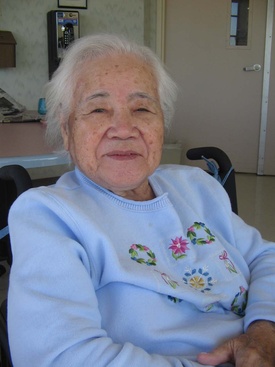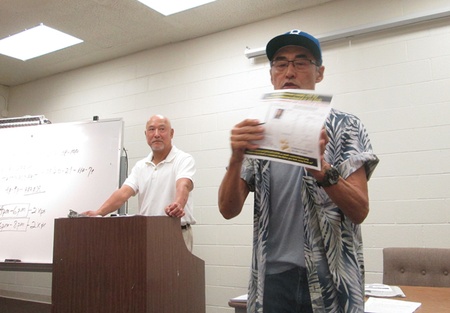Where people meet
There is surely no Japanese or Japanese-American in the Los Angeles area who has not heard of Respect for the Aged Day. In the 1960s, eight Japanese-American community leaders, led by the late Fred Wada, opened a retirement home for the elderly on a hill overlooking downtown Los Angeles. With a full range of Japanese-language services and Japanese food, it was extremely popular with Japanese and Japanese-Americans, who thought it would be a comfortable place to spend their retirement years. People had to wait years to move in, and one Japanese couple I know said, "We make a donation to Respect for the Aged Day every year so that we can move in earlier."
Since 1992, I have frequently visited Keiro facilities for reporting. Keiro operates four facilities: a retirement home in Boyle Heights, near downtown, an intermediate care facility on the same premises, a nursing facility in Lincoln Heights, a little further away, and a nursing facility in Gardena, which has a large Japanese population. The retirement home, built like a condominium, has a spacious cafeteria, and when singers from Japan visit Los Angeles for a performance, there is a high probability that they will also visit Keiro and perform songs for the residents in the cafeteria. It was not only professional singers who visited. There were also many opportunities for children from a Japanese kindergarten to perform plays, and for the wives of Japanese expatriates to sing Japanese songs in chorus.
In addition, some of my friends were instructors who regularly taught lessons to residents and volunteers who served at the coffee shop inside Keiro. They were all Shin-Issei (first generation) people from Japan.
The residents were mostly Japanese Americans and Shin-Issei who had come from Japan to retire in the US, and the visitors were Shin-Issei, children of Nisei born here, Japanese expatriates, and Japanese entertainers visiting Los Angeles for short periods. Keiro was truly a place where people with Japanese roots could come together. Unless you have a Japanese spouse or your child is a member of a Japanese sports league, we Shin-Issei don't have many opportunities to interact closely with Japanese people. So when I visited the Keiro facility, I felt like I had joined the Japanese community in Los Angeles.
The tenant has a history

Naturally, each person living at Keiro had their own story. More than 10 years ago, I met Yae Oyagawa at a nursing home in Lincoln Heights. She was a Japanese-Peruvian who was forcibly taken to the United States during World War II. After being forced to live in an internment camp in the United States, she was unable to return to Peru, so she stayed in Los Angeles and raised her daughter who was born here. Her daughter, Lin, who lives in the city and does not speak Japanese, was also present during the interview. She listened to the interview in Japanese in silence. A few days later, I received a phone call from Lin. She said, "Until then, my mother had never spoken about the hardships she endured during and after the war. But she was really happy that you listened to her story. She said that she had finally put an end to her hardships." At that time, I strongly felt that if I could make people so happy, I would like to visit Keiro after I retire and volunteer to interview and write for residents who want to leave their history for their families.
Many new Issei from Japan show no interest in Japanese society or Japanese people. This is also a factor that creates a wall between them. However, I believe that if you get to know the other person deeply, that wall will disappear. This is the same for Japanese vs. Korean and Japanese vs. Chinese. It is important to know the individual and the other person. In that sense, I think Respect for the Aged Day provided a place for Japanese people and new Issei to meet.
Initiatives of the "Association for Protecting the Elderly"
However, in February 2016, the situation changed. The four facilities were sold to the real estate company Pacifica. The former Keiro facilities changed their names and continue to provide services for seniors. However, the rent has increased, benefits have been cut, nurses have left the company, and there are already complaints that the quality of services has declined. Moreover, the current business model must be maintained for five years after the sale. In other words, it seems that in five years the final resting places for the elderly could be reborn as luxury condominiums with views of downtown skyscrapers, which is irrelevant to the elderly.
But that's not the only problem. Keiro's assets, including the profits from the sale, totaling $73 million, were transferred to KEIRO, an organization that runs health seminars for seniors and is no longer involved in running the facilities. Money that was previously thought to have been "donated to elderly care facilities" is now flowing to organizations with the same name but different content. Volunteers who objected to this have stepped up and formed the "Society to Protect the Elderly," and are holding rallies, demonstrations, and signature campaigns with the goal of returning the $73 million from KEIRO and returning the elderly care facilities to the Japanese community.
And, having received support from many organizations, the Association decided to hold a public debate between the Association for the Protection of the Elderly and KEIRO with the support of one of them, the Japanese American Citizens League. Since I had not been able to cover the activities of the Association for the Protection of the Elderly for the past year, I decided to go and listen to this debate. I was interested to see what kind of opinions each side would have and whether there were any points where I could sympathize with the other side's argument.
However, one week before the event, I received a notice from John Kanai, a director of the Society for Protecting the Aged, that the debate was cancelled. It seems that KEIRO had unilaterally notified them of the cancellation. I can't help but suspect that they are unable to freely exchange opinions and that they have something to hide. So why did they initially agree to hold the debate? It has become increasingly difficult to take my eyes off the issue of Respect for the Aged. On the other hand, a couple I know who said to me about 15 years ago, "I'll donate money to join Respect for the Aged together," have divorced, and a friend who volunteered at a coffee shop because of Respect for the Aged in his old age has already retired and is living in an American senior condo. People's situations and times change. However, I would like to express my sincere respect to the participants of the Society for Protecting the Aged who continue to work towards a solution, believing that the issue of Respect for the Aged should not be forgotten, and I hope that the debate will be held soon.
© 2018 Keiko Fukuda






